
Nazca Booby
Sula granti
Suliformes Order – Sulidae Family
BIOMETRICS :
Length: 81-92 cm
Wingspan: 152 cm
LONGEVITY: Up to 23 years
DESCRIPTION:
Nazca Booby was previously considered as subspecies of the Masked Booby (Sula dactylatra). It is now recognised as full and separate species. Nazca Booby is larger than Masked Booby.
Fr : Fou de Grant
All : Nazca Tölpel
Esp : Alcatraz de Nazca
Ital: Sula di Nazca
Nd: Nascagent
Photographs by Tom Merigan
His website: Tom Merigan’s Photo Galleries
Text by Nicole Bouglouan
Sources:
HANDBOOK OF THE BIRDS OF THE WORLD vol 1 by Josep del Hoyo-Andrew Elliot-Jordi Sargatal - Lynx Edicions - ISBN: 8487334105
All About Birds (Cornell Lab of Ornithology)
The Birds of North America online
Wikipedia (Wikipedia, The Free Encyclopedia)

Adult male has pure white plumage, except the flight feathers and the trailing edge which are blackish-brown. Tail shows white central rectrices and blackish-brown outer tail feathers.
Underparts are white, with blackish-brown trailing edges and undertail feathers.
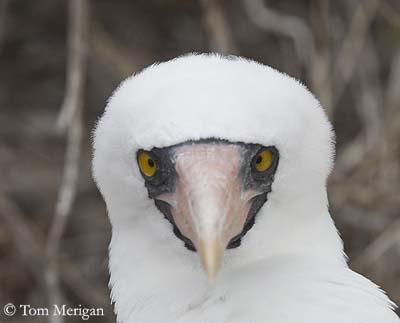
Head and neck are pure white. The bare face is black.
The long, pointed bill is mostly yellowish-orange in male. Eyes are deep yellow to orange. Strong legs and webbed feet are dark grey to olive-blue.
Female has similar plumage, but her bill is pinkish to pinkish-orange. She is slightly larger than male.
Juvenile has grey-brown plumage on the upperparts, with indistinct pale flecks on head and neck.
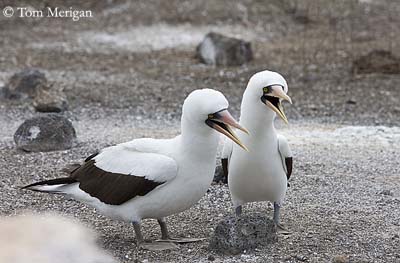
VOICE:
Nazca Booby male, as other boobies, utters mainly plaintive whistles, whereas female gives resonant quacks and honks.
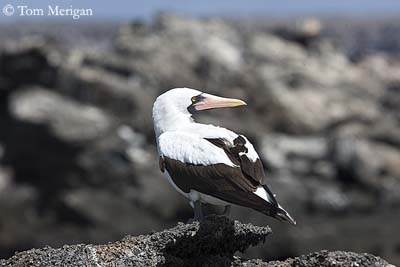
HABITAT:
Nazca Booby is strictly marine. This species nests on cliff-tops, on rocky ledges. Nazca Booby feeds over coastal waters.
RANGE:
Nazca Booby is the species of eastern Pacific Ocean. This species occurs in islands, off the Colombia, Ecuador and Central America coasts.
Recently, Nazca Booby bred in the Hawaiian Islands.
The largest colonies occur on the Galapagos Islands and Malpelo Islands (off the Colombia coasts).
BEHAVIOUR:
Nazca Booby forages in the coastal waters around islands and along the continental coasts of Central and South America.
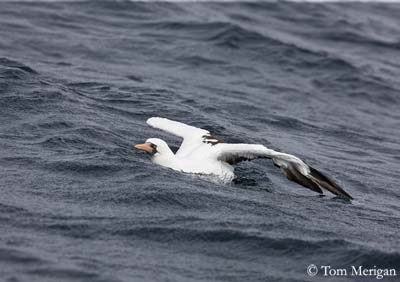
As other Boobies’ species, it performs spectacular plunge-dives from about 30 metres height, directly into the shoals of fishes.
According to the season and the food resources, Nazca Booby feeds mainly on sardina and flying-fish.

Nazca Booby has peculiar behaviour during the breeding season. If the female usually lays two eggs, only one chick is raised. The second dies soon after hatching. The eggs are laid with almost one week interval, and only the older chick is able to survive. It may push the youngest out of the nest and the latter dies by starvation and thirst.
Nazca Booby is known for this obligate siblicide, and parents ignore this behaviour.
Another poorly known behaviour tells that the surviving chicks become like bullies when adults. If they do not breed, they harass the nestlings of the colony, biting them, preening and sometimes trying to copulate with them. (ANDERSON, 2004).
These non-breeding adults perform courtship displays, by offering pebbles or feathers to the young, before forced male copulatory actions.
The persecuted chicks are then often killed by other birds, result of this strange and unusual behaviour.

Breeding pairs have to guard nest and chick strongly, in order to avoid the lost of their single chick.
However, the true mates perform courtship displays such as “billing” between male and female, “bill pointing” and other typical displays.


Nazca Booby remains around the colony-site all year round, but the birds may move according to the food sources.
FLIGHT:
Nazca Booby moves easily into the air, thanks to the long, narrow wings. This bird is highly aerial and performs spectacular plunge-diving after strong flight and good manoeuvrability.
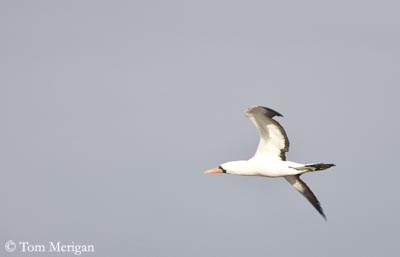
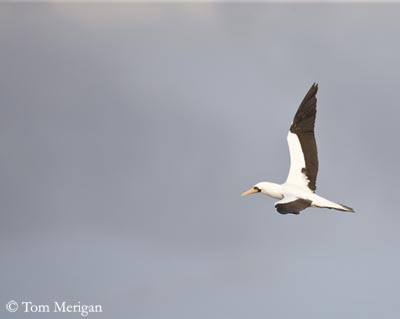
REPRODUCTION:
Breeding season varies according to the range, and Nazca Booby may breed at different periods of the year.
They breed in colonies in rocky ledges in cliffs. The nest is on the ground. The depression is surrounded by a rim of guano.
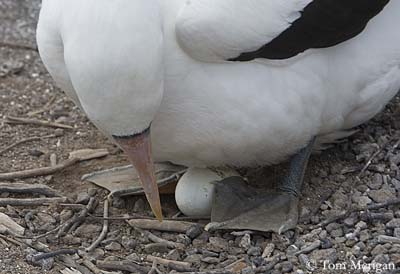
Female usually lays 2 eggs, but only one chick is reared. Incubation by both parents lasts about 40 days. Nazca Booby has not brood-patch and incubates the egg with its webbed feet.
The young is fed by both parents with regurgitated fish. It fledges about 115-120 days after hatching, and reaches its sexual maturity at 3-4 years.
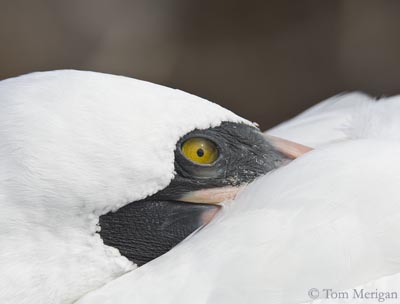
DIET:
Nazca Booby feeds mainly on fish (sardina) and flying fish. This species usually takes larger preys than other boobies.
PROTECTION / THREATS / STATUS:
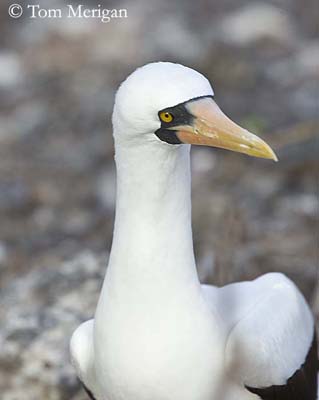
Nazca Booby may be killed by the fishing gear of the boats. They are vulnerable to human developments and disturbances.
Introduced predators also play an important role in nest failure, with the introduced pigs on Clipperton Islands, involving the abandonment of the colony.
Several protection projects are already active, and some populations (on Malpelo Islands) are monitored by ProAves.
However, these birds are locally abundant and the species is not threatened at this moment.